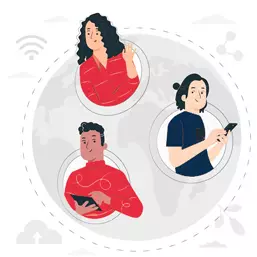
The Art of Assertive Communication
Two monologues do not make a dialogue.
– Jeff Daly
Introduction
Assertive communication is a communication style in which people express their thoughts and emotions clearly and strongly while advocating for their own rights and needs without compromising the rights of others. These people appreciate themselves, their time, and their emotional, spiritual, and physical needs, and they are powerful champions for their own rights while also respecting the rights of others.
Assertive communicators will: state needs and wants clearly, appropriately, and respectfully; express feelings clearly, appropriately, and respectfully; use “I” statements; communicate respect for others; listen well without interrupting; feel in control of self; have good eye contact; speak in a calm and clear tone of voice; have a relaxed body posture; and not allow others to abuse or manipulate them.
The result of an assertive communication pattern is that these individuals: feel connected to others; feel in charge of their life; and are able to mature because they confront concerns and difficulties as they emerge.
“We are equally entitled to express ourselves properly to one another,” the assertive communicator will say, think, or do. “I am confident in who I am.”
“I recognize that I have choices in my life, and I weigh my possibilities.”
“I talk plainly, honestly, and concisely.”
“I have no influence over others, but I do have control over myself.”
“Having my rights recognized is really important to me.”
“I am accountable for ensuring that my requirements are satisfied in a courteous way.”
“I respect other people’s rights.”
“Nobody owes me anything until they choose to give it to me.” “I am solely responsible for my own happiness.”
Assertiveness enables us to care for ourselves and is essential for excellent mental health and strong relationships. It is what we should all strive for since it provides the best of both worlds: you satisfy your demands as well as the needs of the other person, and everyone is pleased.
The Advantages of Being Assertive
1. Improved communication
Your assertiveness benefits both sides. You may obtain what you want out of every contact while still leaving the other person pleased if you speak correctly.
2. Less anxiety
Let’s face it: aggressive communication (as well as passive communication) is stressful; one of the parties engaged usually feels embarrassed or intimidated. If you are “strong,” you may come to regret prioritizing your desire to be heard above the other person’s right to speak.
However, with assertive communication, you acknowledge the other person’s thoughts and wishes while honestly discussing your own and attempting to find the best solution to the problem. This communication approach results in a low level of tension.
3. Increased trust
Trust is essential in both personal and professional relationships, and being aggressive may help you get there more easily. Passive communication often leads in people not taking you seriously, while forceful behavior frequently results in sentiments of animosity.
Being trustworthy in your conversation fosters a strong bond.
4. Increased self-assurance
When you suppress your emotions or engage with people without regard for what others think or feel, you’re either diminishing your self-esteem or constructing it on shaky ground.
However, assertive behavior demonstrates that you are both bold enough to speak up for your rights and in control of what you say (and more importantly, how you say it).
You strike a balance between plainly expressing your wants and allowing the other person to do the same and feel equal.
The 3 C’s Of Assertive Communication
Confidence – You have confidence in your abilities to manage an issue.
Clarity – Your message is clear and simple to grasp.
Controlled – Your present information in a calm and controlled way.
Assertive communication is being comfortable speaking exactly what you want while avoiding hurting the other person’s emotions. It implies that you must let go of the impulse to satisfy everyone and conform to their expectations. When you do this, you are often unhappy and get weaker the next time you attempt to ask for what you want.

Assertive communication may include rejecting items that you determine are not a good match for you, but then articulating why you rejected them in more detail. When it comes to communication, the word “because” may be a game-changer. If you provide compelling arguments and deliver them with conviction, no one will be disappointed that you gave them a negative response.
The self-control that we discussed previously should be used here. Your tone of speech should be relaxed, and you should sound (and feel) calm. This, like learning any new skill, might take some time. Be patient and don’t become frustrated if you wind up raising your voice without realizing it or hurrying through a discussion because you’re agitated.
Assertiveness also entails not displaying hesitancy or roughness in your speech. Maintain a polite and calm demeanor. Speaking slowly and quietly is generally enough to restore balance in the conversation.
Being assertive entails persisting – calmly and respectfully — until the problem is handled. It may need asking more questions, paying more attention, or becoming creative and exploring other choices. Whatever it is, it is worth your time because in the end, both sides are satisfied and no one is harmed.
Brief check
Assertiveness means standing up for your personal rights – expressing thoughts, feelings and beliefs in direct, honest and appropriate ways.

Three-level framework for assertive communication
Engaging in interesting, memorable small talk is a daunting task for most people. How do you know what to share and when to share it? How do you know what topics to avoid? How do you become an engaging converser?
Most experts propose a simple three-level framework that you can use to master the art of assertive communication. Identifying where you are and where you should be is not always easy, but having an objective outline can help you stay out of sticky situations. We will also share some handy networking tips that will help you get conversations started.
Level One: Discussing a wide range of subjects
At the most basic level, stick to general topics: the weather, sports, non-controversial world events, movies, and books. This is typically what people refer to when they say, “small talk.”
At this stage, you will focus on facts rather than feelings, ideas, and perspectives. Death, religion, and politics are absolute no-no’s. (The exception is when you know someone has had an illness or death in the family and wish to express condolences. In this situation, keep your condolences sincere, brief, and to the point.)
If someone shares a fact that you feel is not true, try to refrain from pointing out the discrepancy. If you are asked about the fact, it’s OK simply to say, “I wasn’t aware of that,” or make some other neutral comment.
Right now, you are simply getting to know the other party. Keep an eye out for common ground while you are communicating. Use open-ended questions and listening skills to get as much out of the conversation as possible.
Level Two: Exchanging viewpoints and ideas
If the first level of conversation goes well, the parties should feel comfortable with each other and have identified some common ground. Now it’s time to move a bit beyond general facts and share different ideas and perspectives.
It is important to note that not all personal experiences are appropriate to share at this level. For example, it is fine to share that you like cross-country skiing and went to Europe, but you may not want to share the fact that you took out a personal loan to do so.
Although this level of conversation is the one most often used, and is the most conducive to relationship building and opening communication channels, make sure that you don’t limit yourself to one person in a large social gathering. We’ll offer some ways to mingle successfully in a few moments.
Level Three: Exchanging first-hand accounts
This is the most personal level of conversation. This is where everything is on the table and personal details are being shared. This level is typically not appropriate for a social, casual meeting. However, all of the skills that we have learned today are crucial at this stage in particular: when people are talking about matters of the heart, they require our complete attention, excellent listening skills, and skilled probing with appropriate questions.
Advice on interacting and connecting
Understanding how to converse and how to make small talk are great skills, but how do you get to that point? The answer is simple, but far from easy: you walk up, shake their hand, and say hello!
If you’re in the middle of a social gathering, try these networking tips to maximize your impact and minimize your nerves.

- Before the gathering, imagine the absolute worst that could happen and how likely it is. For example, you may fear that people will laugh at you when you try to join their group or introduce yourself. Is this likely? At most business gatherings, it’s very unlikely!
- Remember that everyone is as nervous as you are. Focus on turning that energy into a positive force.
- To increase your confidence, prepare a great introduction. The best format is to say your name, your organization and/or position title (if appropriate), and something interesting about yourself, or something positive about the gathering. Example: “I’m Tim from Accounting. I think I recognize some of you from the IT conference last month.”
- Just do it! The longer you think about meeting new people, the harder it will be. Get out there, introduce yourself, and meet new people.
- Act as the host or hostess. By asking others if they need food or drink, you are shifting the attention from you to them.
- Start a competition with a friend: see how many people each of you can meet before the gathering is over. Make sure your meetings are worthwhile!
- Join a group of odd-numbered people.
- Try to mingle as much as possible. When you get comfortable with a group of people, move on to a new group.
- When you hear someone’s name, repeat the introduction in your head. Then, when someone new joins the group, introduce them to everyone.
Mnemonics are a great way to remember names. Just remember to keep them to yourself!
Brief check
Being assertive is not the same as being aggressive; on the contrary, assertiveness means expressing your thoughts, emotions, beliefs and opinions in an honest and appropriate manner.
Last but not least, body language, eye contact, posture, listening cues, and emotions are examples of nonverbal communication, all of this should be done without any hostility or passivity. Maintaining eye contact allows you to remain attentive. It’s also a simple technique to show the other person that you’re interested in and care about what they’re saying. According to experts, how you focus your gaze and how long you maintain eye contact may be more essential than what you say.
The key to good communication and building stronger connections is to be aware of what the other person is attempting to communicate. Avoid bringing up old problems or allowing your mind to wander—both of which indicate disrespect and might lead you to lose attention (and therefore, you won’t be able to offer a correct response or be aggressive).
Mindfulness entails being present and not thinking about someone who is not immediately present. Forget about the rest of the world and focus your attention on the person you’re speaking with at the time. Actively listen to what they say.
Avoid aggression in your communication or it will make the other person defensive, whilst being passive would make them feel neglected.
Practical Application
Valerie was experiencing severe performance anxiety as a result of being assigned to give a speech at a workplace event to summarize the year’s achievements. In order to get Valerie into the flow of the discussion, Venus, her assistant, recommended that they practice fundamental conversation skills. But Valerie didn’t know how or where to begin.
Venus guided her using the 3 C’s of assertive communication as well as three-level framework for assertive communication.
She asked Valerie to take a deep breath and begin by becoming confident in her ability to pull this task off with ease. She told Valerie to ensure she knows the topic of the speech well. Valerie agreed to Venus and revised the topic until she gained confidence.
Then following her suggestion of refining the speech for clarity, they went through the three levels of dialogue together. Beginning with broad conversation themes, the discussion evolved to the exchange of thoughts and opinions, and the session concluded with the sharing of personal experiences.
Valerie breezed through the communication skills portion of the course and earned enough confidence to rehearse and deliver her speech in a calm and controlled manner front of an audience. She was delighted to be able to speak and pleased with herself for not making a fool of herself!





